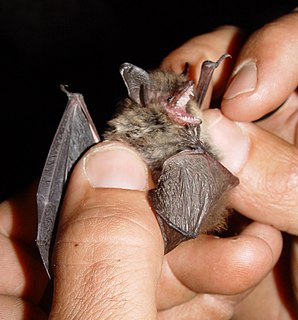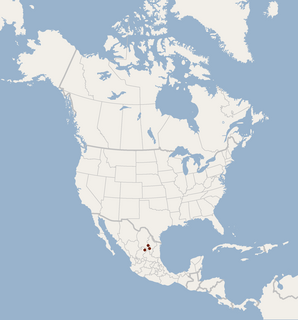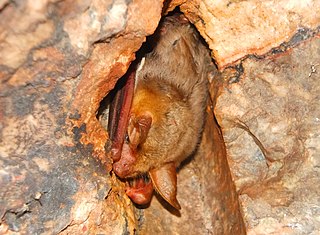
Vespertilionidae is a family of microbats, of the order Chiroptera, flying, insect-eating mammals variously described as the common, vesper, or simple nosed bats. The vespertilionid family is the most diverse and widely distributed of bat families, specialised in many forms to occupy a range of habitats and ecological circumstances, and it is frequently observed or the subject of research. The facial features of the species are often simple, as they mainly rely on vocally emitted echolocation. The tails of the species are enclosed by the lower flight membranes between the legs. Over 300 species are distributed all over the world, on every continent except Antarctica. It owes its name to the genus Vespertilio, which takes its name from a word for bat, vespertilio, derived from the Latin term vesper meaning 'evening'; they are termed "evening bats" and were once referred to as "evening birds".

The mouse-eared bats are a diverse and widespread genus (Myotis) of bats within the family Vespertilionidae.

The big red bat is a species of vesper bat from South and Central America.

The silver-tipped myotis is a species of mouse-eared bat found in a range of lowland habitats in the Americas.

The black myotis, is a vesper bat species from South and Central America.

The velvety myotis, is a species of vesper bat from South America.

The southwestern myotis is a species of vesper bat. It is found in Guatemala, Mexico, and in Arizona and New Mexico in the United States.

The flat-headed myotis is a species of vesper bat. It is endemic to Mexico where it is found in certain montane forests in the Sierra Madre Oriental in the northeast of the country. Once thought to be extinct, this bat was rediscovered in 2004 by Joaquín Arroyo-Cabrales and colleagues. The species is now classified as endangered by the IUCN.

The Felten's myotis is a species of vesper bat.

The little brown bat or little brown myotis is a species of mouse-eared microbat found in North America. It has a small body size and glossy brown fur. It is similar in appearance to several other mouse-eared bats, including the Indiana bat, northern long-eared bat, and Arizona myotis, to which it is closely related. Despite its name, the little brown bat is not closely related to the big brown bat, which belongs to a different genus.

The Annamit myotis is a species of mouse-eared bat in the family Vespertilionidae, described in 2001, and indigenous to the Minh Hóa Districton the northern coast of Vietnam. Following its description, investigators succeeded in locating M. annamiticus only in Phong Nha-Kẻ Bàng National Park, and the data regarding the distribution, population, and range of the species is otherwise inadequate to determine its conservation requirements. However it is protected by Phong Nha-Kẻ Bàng National Park.

A maternity colony refers to a temporary association of reproductive female bats for giving birth to, nursing, and weaning their pups. The colonies are initiated by pregnant bats. After giving birth, the colony consists of the lactating females and their offspring. After weaning, juveniles will leave the maternity colony, and the colony itself will break apart. The size of a maternity colony is highly variable by species, with some species forming colonies consisting of ten or fewer individuals, while the largest maternity colony in the world in Bracken Cave is estimated to have over 15 million bats.
Cimex adjunctus, is an ectoparasite found in a wide range of North America. Like other insects in the genus Cimex, C. adjunctus is a temporary parasite that eats blood. Temporary, meaning that they do not linger on their hosts between meals. C. adjunctus feed off of many insectivorous bat species. On more than one occasion, these insects have been found on the wings of Eptesicus fuscus.
Sir David Attenborough's myotis is a species of small bat in the family Vespertilionidae that is endemic to the Caribbean island of Tobago. Its presence on nearby Trinidad is as yet uncertain. It is the only mammal species currently known to be endemic to Trinidad and Tobago. It was named after famed English naturalist Sir David Attenborough.
Spinturnix americanus is a species of mite that parasitizes bat wings. It was described as a new species in 1902 by American entomologist Nathan Banks. Banks initially placed it in the now-defunct genus Pteroptus. The holotype had been collected from a bat in a cave in Indiana. Species that it affects include the little brown bat, northern long-eared bat, and riparian myotis. It has been documented affecting bats in Indiana and Pennsylvania in the United States, Nova Scotia in Canada, and Mato Grosso in Brazil.
Myotis diminutus is a species of mouse-eared bat found in Ecuador and Colombia. It was recently described as a new species in 2011.

Myotis izecksohni is a species of mouse-eared bat that is endemic to Brazil and Argentina.
Myotis annatessae is a recently described species of bat in the family Vespertilionidae. It is endemic to Vietnam and Laos.












